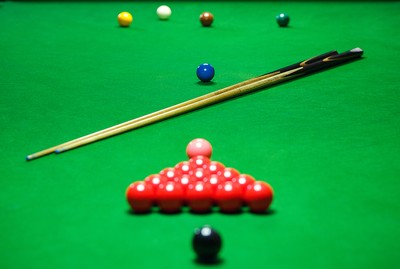 Each sport has its own mark of perfection that players strive to achieve. In football, for example, a player that scores a hat-trick gets to walk away with the match ball at the end of the game. Whilst this might have less significance in the era of multi-ball play, it still means something to those that have achieved the feat of scoring three goals or more in a game. In golf, that feat is a hole-in-one, which is a rare enough occurrence to mean that some amateur golfers take out insurance against it, owing to the tradition of having to buy everyone in the clubhouse a drink after managing it. Similar feats in other sports include a 300 game in ten-pin bowling or a nine-dart finish in darts.
Each sport has its own mark of perfection that players strive to achieve. In football, for example, a player that scores a hat-trick gets to walk away with the match ball at the end of the game. Whilst this might have less significance in the era of multi-ball play, it still means something to those that have achieved the feat of scoring three goals or more in a game. In golf, that feat is a hole-in-one, which is a rare enough occurrence to mean that some amateur golfers take out insurance against it, owing to the tradition of having to buy everyone in the clubhouse a drink after managing it. Similar feats in other sports include a 300 game in ten-pin bowling or a nine-dart finish in darts.
For snooker players, the thing that they want to do is score a 147. The truth is that it isn’t all that rare for a player to score a 147, with some competitions even having several of them scored during the tournament. That doesn’t mean that it’s any less special for a player to manage it, even at the professional level. It is just that the answer to the question could change at any moment. With that in mind, it is worth pointing out that we’re are looking at data up to the end of February in 2024, so if a player goes on a run of scoring 147s and shoots to the top of this list then you know why it is that we haven’t included them in the conversation yet.
Quick Answer: Which Snooker Player Has Scored the Most Maximum Breaks?
As of 2024, Ronnie O’Sullivan holds the record for the most snooker maximum breaks with 15. His first came against Mick Price at the 1997 World Championship, with his 15th and latest recorded at the English Open in 2018 when playing Allan Taylor.
Up to the end of February 2024, there have been 200 official maximum breaks scored in professional snooker tournaments. The first of these was scored by Steve Davis in the 1982 Lada Classic against John Spencer.
What is a 147?
In snooker, the maximum that a player can score from a break is 147. This is achieved by potting all 15 of the red balls, which are worth a point each, following by a black each time. The black is worth seven points, so potting a black 15 times will give a player 105 points for a running total at that time of 120. At that point, the player then needs to pot the rest of the colours in order, starting with the yellow, followed by the green, brown, blue, pink and finally the black. Each ball is worth the following points:
Snooker Colour Values
| Colour | Points |
|---|---|
| Red | 1 |
| Yellow | 2 |
| Green | 3 |
| Brown | 4 |
| Blue | 5 |
| Pink | 6 |
| Black | 7 |
That means that there is an additional 27 points on offer, which would then be added to the 120 scored earlier for a total of 147 points.
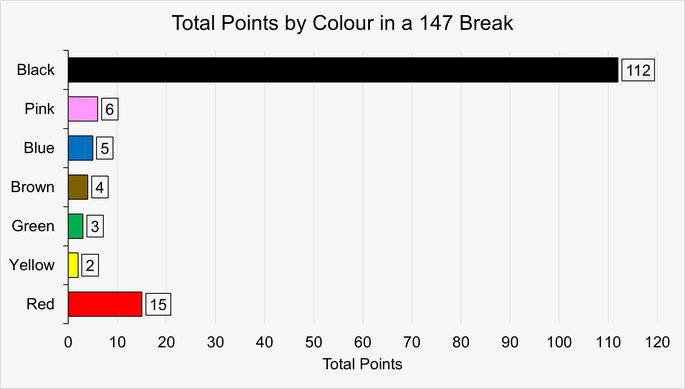
Technically it is possible for a player to score more than 147, should their opponent cause a foul that would see points added to the other player’s score, but that would obviously mean that the player going for the 147 would need to have missed a shot and therefore their ‘break’ would be over. A maximum break is only counted as such if the player pots a ball from the break of the game and then pots all of the other balls in the order described.
History of the 147 Break
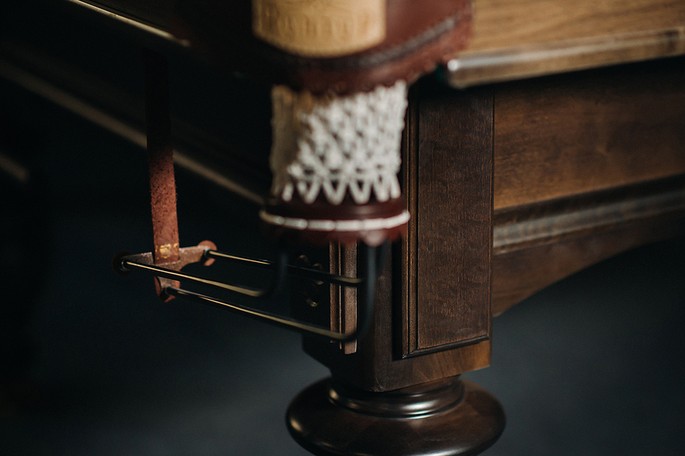
The first recognised 147 took place in 1955 when Joe Davis achieved one during an exhibition match in London whilst playing against Willie Smith. Initially, the Billiards Association and Control Council had refused to acknowledge Davis’ break on account of the fact that the competition hadn’t been played under their rules. It took until two years later for the BACC to official accept that Davis had indeed managed the first 147 break, giving him a certificate to commemorate his achievement. There was another maximum break in 1979 at the Holsten Lager International, but John Spencer had not been playing on what was known as a ‘templated table’.
Remarkably, it took nearly 30 years for a professional competition to feature a 147 break, which was managed by Steve Davis during the 1982 Classic and was, somewhat ironically, achieved against Spencer. That also happened to be the first time that a 147 had been achieved in a televised match, coming just two years after the Classic had taken place for the first time and resulted in Davis being given a Lada car by the event’s sponsors. A year later and another first was achieved, this time when Cliff Thornburn became the first player to get a 147 break in the World Snooker Championship at the Crucible Theatre in Sheffield.
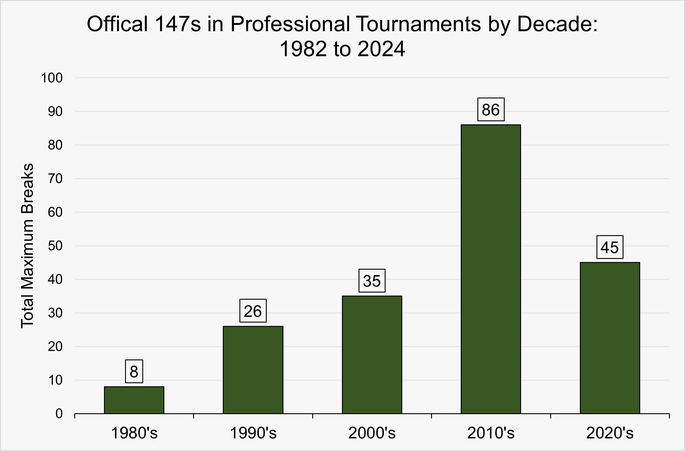
One of the most interesting things about a 147 maximum break is that they have become more common as time has gone on, as indicated by the chart above. Prior to the start of the 1994-1995 season, only 15 maximum breaks were officially recognised as having taken place in competition. Since then, however, at least one 147 has happened every season. In both the 2016-2017 and the 2022-2023 seasons, 13 maximum breaks of 147 were achieved, which is the highest number in a single season at the time of writing. On the seventh of December 2013, Mark Selby achieved the 100th official 147 maximum break in competition in his semi-final match against Ricky Walden at the UK Championship.
The Top Players For 147s
As you might imagine, some players seem to be a little more attuned at managing the maximum break of 147 than others. Here is a look at those that have pulled it off the most times as of writing this piece, going down to those that have managed it at least five times:
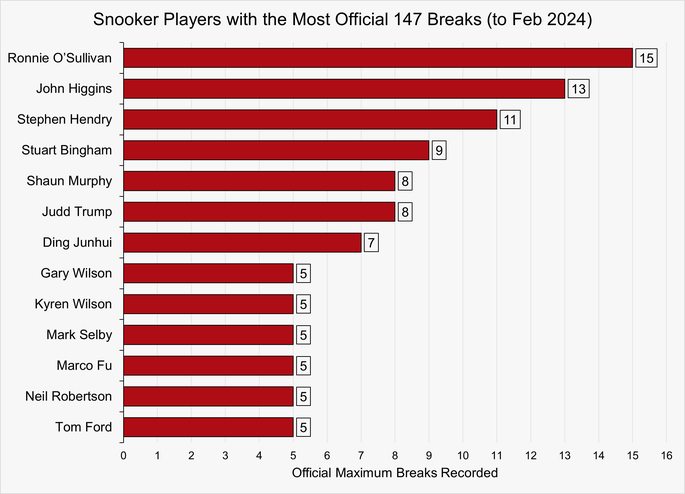
Ronnie O’Sullivan – 147 Master
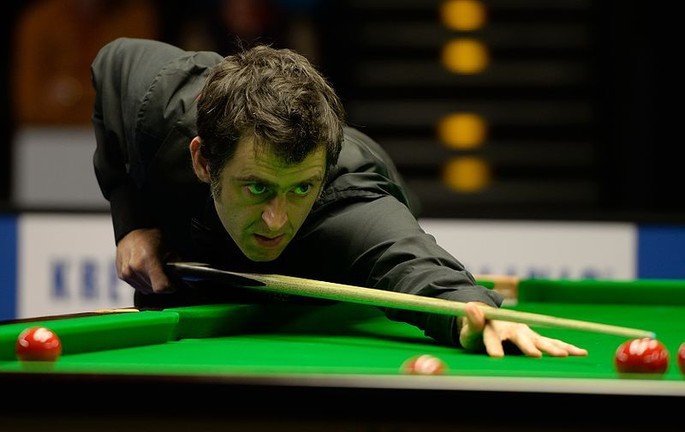
Ronnie O’Sullivan holds the record for both the most maximum breaks with 15, and the quickest maximum break at 5 minutes, 8 seconds. Photo by DerHexer Wikimedia Commons
There is a solid argument that Ronnie O’Sullivan is the best snooker player ever to pick up a cue. Born Ronald Antonio O’Sullivan on the fifth of December 1975 in Wordsley in the West Midlands, O’Sullivan holds the record for the most wins in the World Snooker Championship in the modern era with seven, level with Stephen Hendry. He has also won the Masters and the UK Championships eight times apiece, meaning that he’s got 23 Triple Crown titles, which is the most of any snooker player. With 41 Ranking Titles he is, as you might have guessed, the record holder on that front too. Part of his success no doubt comes from the fact that he can play left-handed as well as right, if needed.
O’Sullivan won a number of amateur titles before choosing to turn professional in 1992 when he was just 16-years-old. It took him less than two years to win his first ranking title when he won the UK Championship in 1993, becoming the youngest player to do so at the age of 17 years and 358 days; a record that he still holds today. He later became the youngest player to win the Masters and would go on to become the oldest player to win all three of the Triple Crown events. It is entirely fair to say that Ronnie O’Sullivan is a phenomenal snooker player, achieving his first century break aged just 10-years-old.
O’Sullivan’s first maximum break in a competition came when he was 15-years-old, doing so at the English Amateur Championship in 1991. At the 1997 World Championship, O’Sullivan recorded a 147 maximum break in five minutes and eight seconds, which is in the Guinness Book of World Records as being the fastest such break ever achieved in a competition. What makes that even more remarkable is the fact that it was the first maximum break of 147 that he’d managed in the tournament, as well as the first that he’d achieved in an official competition. It is perhaps not all that surprising that he holds the record for the maximum, given that he also holds the record for the number of century breaks.
Finally finished the updated multiscreen of Crucible 147 breaks ranked by speed. Look at the state of the other tables when Ronnie O’Sullivan finishes his first…pic.twitter.com/lHajsm8Qbb
— Chris Hammer (@ChrisHammer180) May 16, 2023
Here is a look at the 15 maximum breaks of 147 that Ronnie O’Sullivan has managed in his career to date, including the competition that it took place in, the round of said competition and his opponent:
Ronnie O’Sullivan’s Official 147 Maximum Breaks
| Date | Opponent | Competition | Round |
|---|---|---|---|
| 21st Apr 1997 | Mick Price | World Championship | Last 32 |
| 29th Jan 1999 | James Wattana | Welsh Open | Quarter-finals |
| 13th Oct 1999 | Graeme Dott | Grand Prix | Last 32 |
| 5th Apr 2000 | Quinten Hann | Scottish Open | Last 32 |
| 17th Oct 2001 | Drew Henry | LG Cup | Last 16 |
| 22nd Apr 2003 | Marco Fu | World Championship | Last 32 |
| 8th Nov 2007 | Ali Carter | Northern Ireland Trophy | Last 16 |
| 15th Dec 2007 | Mark Selby | UK Championship | Semi-Final |
| 28th Apr 2008 | Mark Williams | World Championship | Last 16 |
| 20th Sept 2010 | Mark King | World Open | Last 64 |
| 26th Aug 2011 | Adam Duffy | Paul Hunter Classic | Last 32 |
| 2nd Mar 2014 | Ding Junhui | Welsh Open | Final |
| 4th Dec 2014 | Matthew Selt | UK Championship | Last 16 |
| 3rd Apr 2018 | Elliot Slessor | China Open | Last 64 |
| 17th Oct 2018 | Allan Taylor | English Open | Last 64 |
Not only did O’Sullivan achieve a maximum break of 147 in the above matches but he also managed to so in moments when it really mattered on more than a few occasions. Against Mark Selby in the 2007 UK Championship, for example, he did it in the deciding frame of the match. Similarly, the 147 came in the last frame of the match against Mark Williams in 2008 and Mark King in 2010. In order to prove that he didn’t just do that in matches against people named Mark, he also pulled it off in the final frame of his match against Ding Junhui in 2014, Matthew Self in the UK Championship later that year and Allan Taylor in the English Open in 2018. It is also interesting that all 15 breaks have come against different players.
The Near Misses
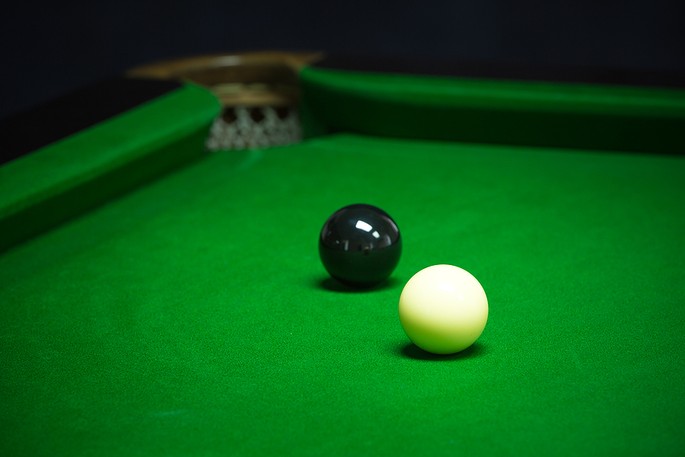
Whilst O’Sullivan unquestionably deserves to be at the very top of our list for what he has achieved on a snooker table by racking up the most 147s, there are a few players who have come close achieving more during their careers only to miss out on the final black. Though this list isn’t exhaustive, it is interesting. Here are the players that finished their break on 140:
- Robin Hull
- Ken Doherty
- Barry Pinches
- Mark Selby
- Michael White
- Thepchaiya Un-Nooh
- Liang Wenbo
Somewhat remarkably, Thepchaiya Un-Nooh actually finished on 140, narrowly missing out on a 147 maximum break, twice during the same season. The unfortunately accomplishment happened in the 2015-2016 campaign.
When Liang Wenbo missed out on his 147 maximum break in his qualifying round of the World Championship, he could at least console himself that he had already managed a 147 earlier in the same match.
Other Noteworthy Accomplishments
There are, of course, a few other noteworthy accomplishments when it comes to the discussion around maximum breaks. There have, for example, been 20 occasions in which more than one 147 has been achieved during the same competition. That happened for the first time at the World Snooker Championship in 2008 when two 147 maximum breaks were broadcast. There have been. Two occasions in which three official maximum breaks have happened in the same World Professional Billiards and Snooker Association event, with the first being the 2012 UK Championship and the second at the 2017 German Masters.
There has only been one break of more than 147 in professional competition, which occurred in 2004 when Jamie Burnett scored 148 in the UK Championship during the qualifying stage. In 2005, Jamie Cope made a break of 155 during a practice round of the same competition, with some saying that Alex Higgins managed the same thing. These feats required the opposition player to foul whilst all 15 reds were still on the table.
